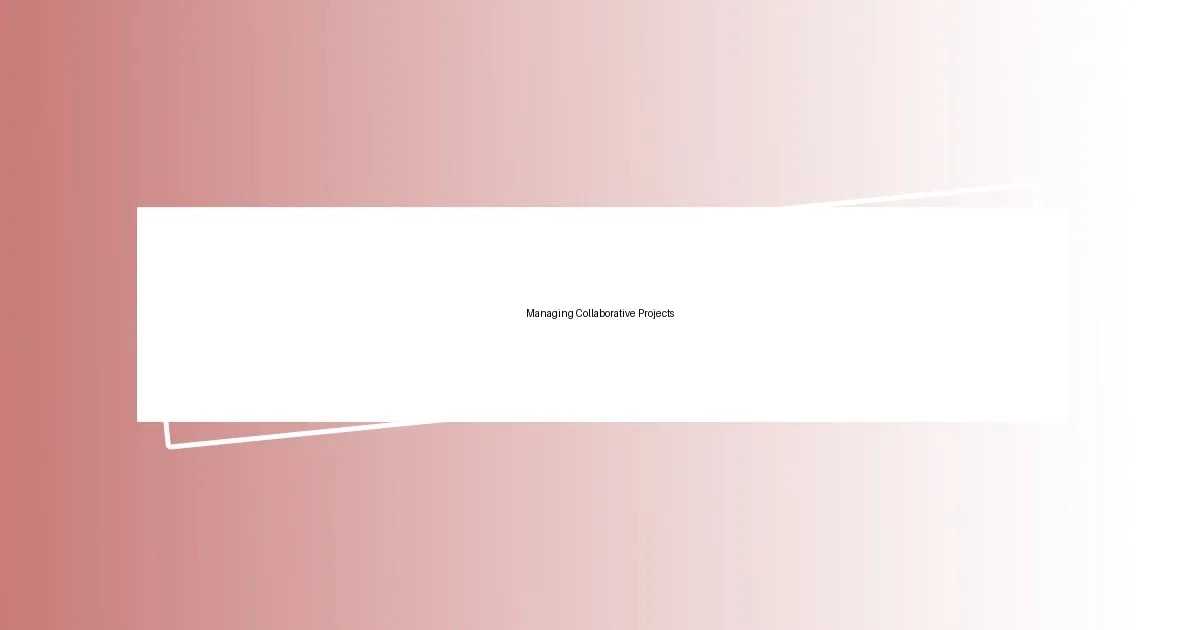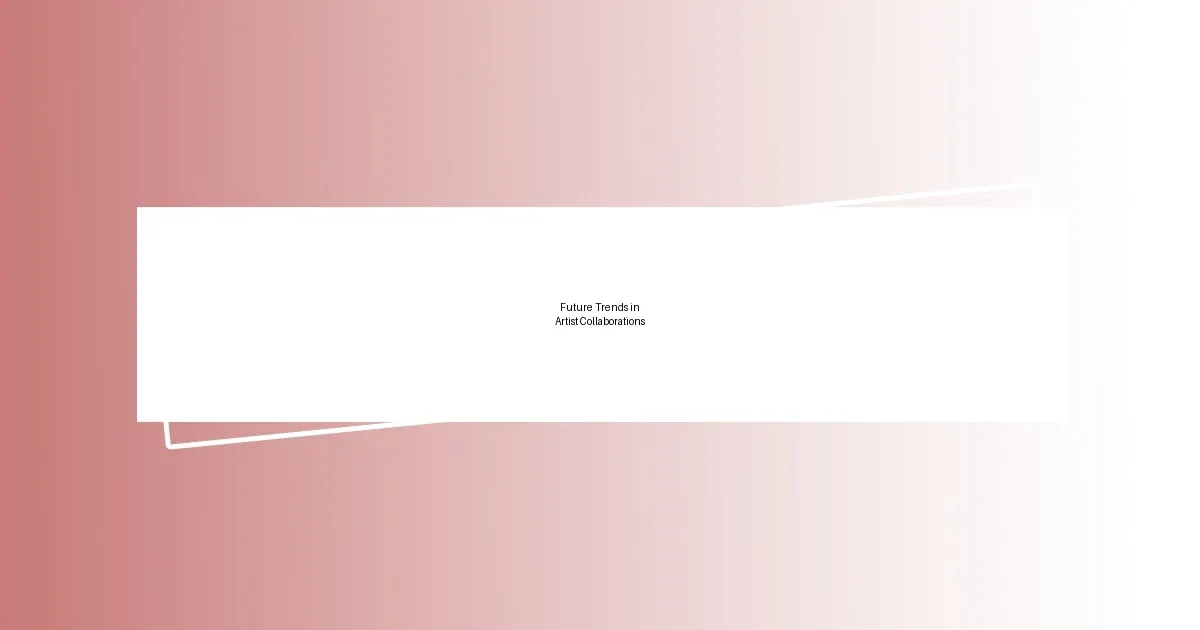Key takeaways:
- Artist collaborations enhance creativity by merging different perspectives, leading to richer artistic outcomes and mutual growth.
- Effective communication, including active listening and visual references, is crucial for successful collaborations.
- Future trends in collaborations are leaning towards interdisciplinary approaches, utilizing technology and sustainability to foster innovation.

Understanding Artist Collaborations
Artist collaborations are fascinating because they combine different perspectives, techniques, and experiences into a single piece of art. I remember working on a project with a graphic designer, where our differing styles initially clashed. But as we navigated through our creative differences, we discovered unique ways to infuse both visions, leading to something far more compelling than I could have created alone.
There’s something magical about the synergy that happens during collaboration. Have you ever watched two artists feed off each other’s energy? I’ve seen how their passion can excite not only the artists but also the audience. This exchange not only enhances the final outcome but often leads to deeper connections and friendships that extend beyond the canvas.
Understanding artist collaborations goes beyond technique; it’s about mutual respect and shared growth. I’ve found that every collaboration I engage in teaches me something new, whether it’s a fresh approach to color or a different mindset toward feedback. It’s incredible how these experiences reshape my artistic journey, pushing me to take risks I might not have considered otherwise.

Benefits of Collaborating with Artists
Collaborating with artists can significantly expand your creative horizons. I remember a time when I partnered with a sculptor. At first glance, our work seemed completely different, yet through collaboration, I discovered new materials and techniques I never imagined using. This exchange not only enriched my artistic repertoire but also taught me how blending different mediums can create something entirely original.
Another key benefit is the exposure to diverse audiences. When I worked with a musician on a multimedia project, we tapped into each other’s networks. Suddenly, my artwork reached music lovers who might not have found it otherwise. It was a thrilling moment to see my work appreciated by a fresh audience, showcasing how collaboration can bridge gaps and build new communities around shared passions.
Moreover, collaborating with artists fosters a sense of accountability and motivation. There’s this feeling of excitement and commitment when you have someone to create with. Last summer, I teamed up with a painter for an art fair. Knowing someone was counting on me pushed me to meet deadlines and stay focused, ultimately elevating the quality of my work. It’s a mutual inspiration that often leads to unexpected outcomes.
| Benefit | Description |
|---|---|
| Expanded Creative Horizons | Collaboration introduces new techniques and mediums, enhancing personal skills. |
| Diverse Audience Exposure | Working with others can connect you to new audiences and communities. |
| Increased Accountability | Having a collaborator boosts motivation and commitment to projects. |

Finding the Right Collaborators
Finding the right collaborators can truly make or break an artistic project. I recall a time when I was searching for someone to work with for a community mural. Initially, I felt overwhelmed by the options, but then I took a step back and reflected on what I wanted to achieve. I realized that I needed someone whose vision resonated with mine—a balance of shared ideas and unique perspectives. Ultimately, I partnered with a local muralist who had an incredible knack for storytelling through art, and the end result was a beautiful tapestry of our combined themes.
When looking for collaborators, consider factors beyond just technical skills. Personal values, communication styles, and creative visions should all align to foster a harmonious working relationship. Here are a few pointers to help you in your search:
- Shared Vision: Identify collaborators who understand your artistic goals and can contribute meaningfully to them.
- Complementary Skills: Seek those whose strengths enhance your weaknesses. This can lead to a richer outcome.
- Effective Communication: Choose collaborators who are not only receptive to your ideas but also comfortable sharing their own.
- Passion and Commitment: Look for individuals who exhibit dedication to their craft and a willingness to engage fully in the project.
- Emotional Compatibility: Collaborate with artists who share a similar emotional approach to art, as this can deepen your connection and enhance the final piece.
Finding the right match may take time, but the rewards of a meaningful collaboration are invaluable, often leading to art that surpasses our individual capabilities.

Communicating Effectively with Artists
When I think about effective communication with artists, I can’t help but remember my first experience trying to explain my vision for a joint installation. It was challenging to articulate my ideas clearly, especially when we seemed to be speaking different creative languages. This taught me an essential lesson: don’t shy away from using visual references or sketches. They can bridge the gap between imagination and reality, ensuring that everyone is on the same page. Have you ever felt misunderstood during a creative discussion? I’ve learned that sometimes, a simple drawing can save hours of confusion.
Another vital aspect of communication is active listening. I recall collaborating with a digital artist who had a unique take on color palettes I hadn’t considered. Instead of simply pushing my own ideas, I made a conscious effort to listen to her thoughts. This not only made her feel valued but also sparked new directions in our project that I hadn’t anticipated. It reinforced the idea that by genuinely hearing others, we can expand our creative potential. Have you ever had that “Aha!” moment when someone else’s perspective shifted your entire approach? Those moments can redefine your work.
Finally, I find that establishing a comfortable atmosphere for open dialogue is crucial. During a recent project with a performance artist, we held regular check-ins over coffee, creating space for candid conversations. These relaxed moments encouraged us to express concerns and suggestions freely without the pressure of formal meetings. It made the collaboration feel organic and enjoyable. How do you create that space in your own projects? In my experience, fostering an environment of trust can transform not just the process but the end result, leading to truly collaborative art that reflects the best of both creators.

Managing Collaborative Projects
Managing collaborative projects requires a blend of organization and flexibility. I remember a collaborative live painting event where everything was meticulously planned, from the theme to the logistics. However, on the day of the event, unexpected weather forced us to reconsider our setup. Instead of panicking, I encouraged my team to brainstorm alternative approaches. By embracing adaptability, we not only salvaged the project but also enhanced it by creating a more intimate setting indoors. Have you ever faced a twist in your plans that turned out to be a hidden blessing?
Another crucial aspect is establishing clear roles and responsibilities from the outset. In one project, I collaborated with several performers, and we were all eager to contribute ideas. However, without defined roles, things quickly became chaotic. I suggested that we create a simple chart outlining who was responsible for what. This clarity allowed us to focus on our strengths and work more efficiently. Was there a time when ambiguity derailed your creative efforts? Recognizing roles early on can save countless headaches down the line.
Ultimately, maintaining open channels for feedback is vital. During a recent mural project, I made it a point to schedule weekly check-ins where everyone could voice concerns or share insights. It was during one of these discussions that a fellow artist suggested a surprising color change. Initially hesitant, I realized my preconceived notions were limiting our creative potential. This kind of interactive feedback loop fosters growth and leads to results that resonate more deeply with everyone involved. Have you opened the floor for spontaneous ideas in your projects, and how did that transform the creative direction? Embracing feedback not only refines the work but also strengthens team dynamics.

Future Trends in Artist Collaborations
The future of artist collaborations is undeniably leaning toward a more interdisciplinary approach. I recently witnessed this firsthand when a musician and a visual artist teamed up for an immersive installation that combined sound, light, and visual art. The result was something that transcended individual mediums, creating an experience that was both engaging and thought-provoking. Have you ever experienced an artwork that brought together different forms of expression seamlessly? It felt like the boundaries between disciplines were melting away, paving the way for collaborations that are not just about adding layers but creating entirely new dimensions of art.
I also see technology playing a starring role in how artists collaborate moving forward. Take virtual reality, for instance; I learned how two artists used VR to build a shared space where they could create together, even from miles apart. This technology allowed them to visualize their work in 3D, shaping ideas in real-time as if they were in the same room. Have you ever imagined how far you could push your creativity if geographical constraints weren’t a factor? It’s exhilarating to think that the future could bring even more innovative tools that facilitate this kind of synergy.
Sustainability is another essential trend emerging in artist collaborations. I’ve recently been involved in a project where my co-creator and I focused on upcycling materials to minimize waste. It was eye-opening to source our supplies from local discarded items, which not only contributed to a more responsible practice but sparked new creative ideas we never would have explored otherwise. Have you considered how embracing sustainability might shift your perspective on collaboration? These projects not only illustrate our commitment to the environment but also foster a sense of community, as artists come together for a common cause, turning challenges into creative opportunities.














